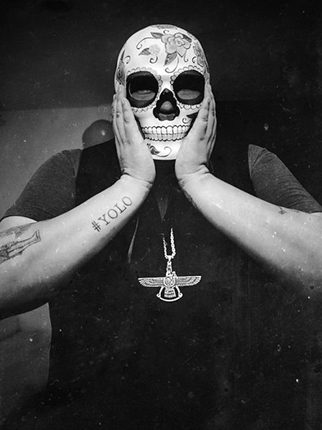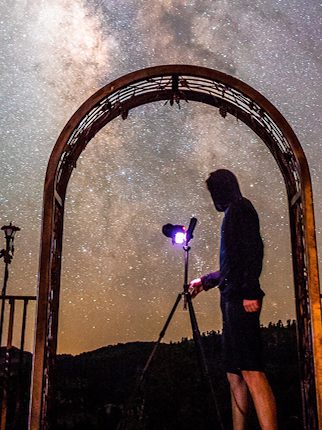1,000 Words: Skyler Greene
Skyler Greene is hopeful.
Over the course of an afternoon in downtown L.A.’s arts district, Greene’s relentless optimism is on full display as he talks about art, music, technology and nature and how they all come together in his own work—most notably photography and the ongoing series of intimate, transformational SkyFish events he has an influential hand in producing.
Growing up in Marin County, California, under the looming shadow of nearby San Francisco, his fascination with art and seeing things differently started at a young age.
“Marin’s a really special area, in that it’s just far enough away from San Francisco where you don’t feel like you live in a city, but downtown is just a 10-minute drive away. You’re surrounded by redwood forests and beautiful hills, and it feels like a beautiful oasis,” he explains. “I did a lot of exploring in nature during my formative years. As I got older, I’d spend a lot of time going to clubs and music venues. So I had this weird split between nature-loving hippie and techno-head underground club rat.”
Greene is open and forthcoming about his work, which he hopes will help motivate others to seek out more from their social lives than just a good time.
“I spent my time in clubs drinking and partying and whatnot. It just wasn’t fulfilling,” he admits. “Now I can go to some of these festivals where they have more of a strong intention set behind why it’s happening. I can go there completely sober and walk away totally fulfilled and with a stronger grasp over my community and my own ideas and generally feel inspired. It’s that spark I really want to share with other people.”
One of the reasons we’re here is to talk about your photography. How did you get started on that path?
When I was a little kid, my mom handed me a camera, and I used to see everybody take pictures vertically or horizontally. I was like, since everybody does it this way, I’m going to do it diagonally. I like to say I started as a toddler, but I really started taking photography seriously in high school under the direction of Chuck Ford, one of my wilderness teachers, who studied under Ansel Adams. I’d been shooting professionally by the time I graduated.
Was school a positive experience?
I went to a wilderness program at my high school district, called TEAM. It was quite small and intimate, which really allowed me to flourish. Then in my senior year, I decided to do an independent study, which meant that I had time outside of school to do more photography. My college education consisted of three study-abroad semesters in Germany, Italy and Sweden, which was another launching point for my art. After coming back to California to graduate from UC Merced, I went to Berlin for a year to study design at the Hasso Plattner School of Design Thinking.

What were those two years in Europe like for you?
It was completely life-changing. When I first came back, it was all I could talk about. I did a lot of exploring of art while I was there. I probably could’ve spent more time on my actual studies, but instead, I did a lot of traveling. That’s when I started moving my photography in a more artistic direction. In Berlin, I was an apprentice for this British photographer, Vincent Barker. He was doing a lot of amazing large-format film work in studio. He took me under his wing and showed me everything I needed to know about everything from film to how to manage a business. It was really eye-opening.
How did you end up in Los Angeles?
It just sort of happened. I didn’t actively want to move here. I came back from Berlin and started a road trip that I developed with a friend of mine, Elissa Freiha. We drove from New York City to L.A. across 55 days and 12,500 miles. In the middle of that, I got a call from a record label I’d been working remotely for, Stealth Records, which is Roger Sanchez’s label. I’d done an internship with them during college, and they hit me up looking for digital assets and a social media manager. They offered me a job in L.A., which is how I ended up here.

How did you develop your love of music?
Music has always been an influential part of my life, from my dad turning me on to some classic-rock-era records on vinyl—anything from the Faces and Rod Stewart to the Doors and Jefferson Airplane. I became pretty obsessed with Woodstock at that point, which lent itself well to my hippie lifestyle, on one end of the spectrum. Then I went to summer camp and was rooming with these French kids that were really into weird electronic music.

From there, I went on to check out more and more electronic music, starting with more of the mainstream stuff and then diving deeper into it, especially during my time in Rome. I’d started DJing and thought it would be really cool to DJ in Rome. I finally got some promoters there to book me, and eventually I was doing like three gigs a week and not going to class. I’d never failed a class before, and I failed three in one semester. That led me down the road into Berlin and techno, which was the complete opposite of the scene in Italy. So I waltzed up to Berghain in a nice pair of shoes and a collared shirt with a woman on my arm, and of course we didn’t get in. That really sparked my curiosity about that whole underground movement. I’ve been obsessed with techno ever since.
What kind of music do you play as a DJ?
I found this kind of mix between this happy-somber type of techno; it wasn’t so hard and driving. It was more happy, outdoor music, but still danceable. I connected with another American during my time in Germany, James Fish, and that developed into a friendship and the two of us starting to play music together. We started to throw these underground open-air festivals in Berlin. That led to us continuing the project when we moved back to California, which evolved into SkyFish.
Essentially, what we make are thematic mixes that are based on dance music, but integrate a lot of academic narration and elements of spirituality. I like to call it a “sound project” rather than a DJ duo, because what we’re doing is bringing more than just music. It’s about bringing the experience to the people in an environment that’s beautiful. We have this philosophy behind what we do that’s a triad between nature, music and humans. This summer, we were able to bring SkyFish to Turkey, Italy, Germany and Iceland… I look at it as a way of giving back in the experience of music, but also outside of music in the form of workshops, mediation, seminars and discussions. We utilize the space we build for music into other things.
What’s the motivation behind SkyFish events?
We base a lot of philosophy off of transformational festival culture, which basically means everybody is bringing something to the table. Everybody is a contributor, a collaborator; nobody is solely a participant. Everybody is helping to build this up so that the whole community can come together to strengthen that vibe and steer the direction of the community. Going to Burning Man multiple times has had a tremendous influence on me.

What’s your process as a photographer in finding that perfect moment when you’re shooting in the chaotic environment of a festival or live show?
I have a pretty heavy trigger finger. I take a lot of photos at festivals because there’s so much happening all the time. I’d say it’s one part conditioning and one part a creative eye. Predictability factors in a lot with shooting music. You start to recognize patterns in the sound and the lighting, and you start to anticipate when that certain moment is going to happen, and you’re ready for it. It might not sound very artistic, but there is an air of art to that. Ultimately, you have to understand what makes a strong image.

“A triple-exposure on film in Iceland of our friend Mara. SkyFish spent a week traveling around by car, camping wherever inspiration struck.”

“Asha and I on Moro Rock in Sequoia National Park, celebrating the moonrise.”

“I chased this damn boat around Burning Man for nearly three hours, trying to get this shot! We were waiting for the perfect conditions and the right amount of dust in the air for the magic to happen.”

“John Muir had it right: Nature IS the best medicine. This was taken on Aloha Lake while backpacking through Desolation Wilderness a couple years back.”

“This one is from my latest shoot. Fourteen people came together in the Algodones Dunes to create imagery that aims to propagate peace and harmony.”

“This will be on the inside cover of my memoirs that I will write when I’m in my 70s. This one was taken outside some plane wreckage in Iceland.”

“Richie Hawtin closing out Escape 2015 on the ENTER. stage. Always love me some dark Halloween techno.”

“Kaskade closing out EDC Orlando 2015.”
Go here to see a gallery of Skyler’s work.
Follow Skyler Greene on Facebook | Twitter | Instagram







